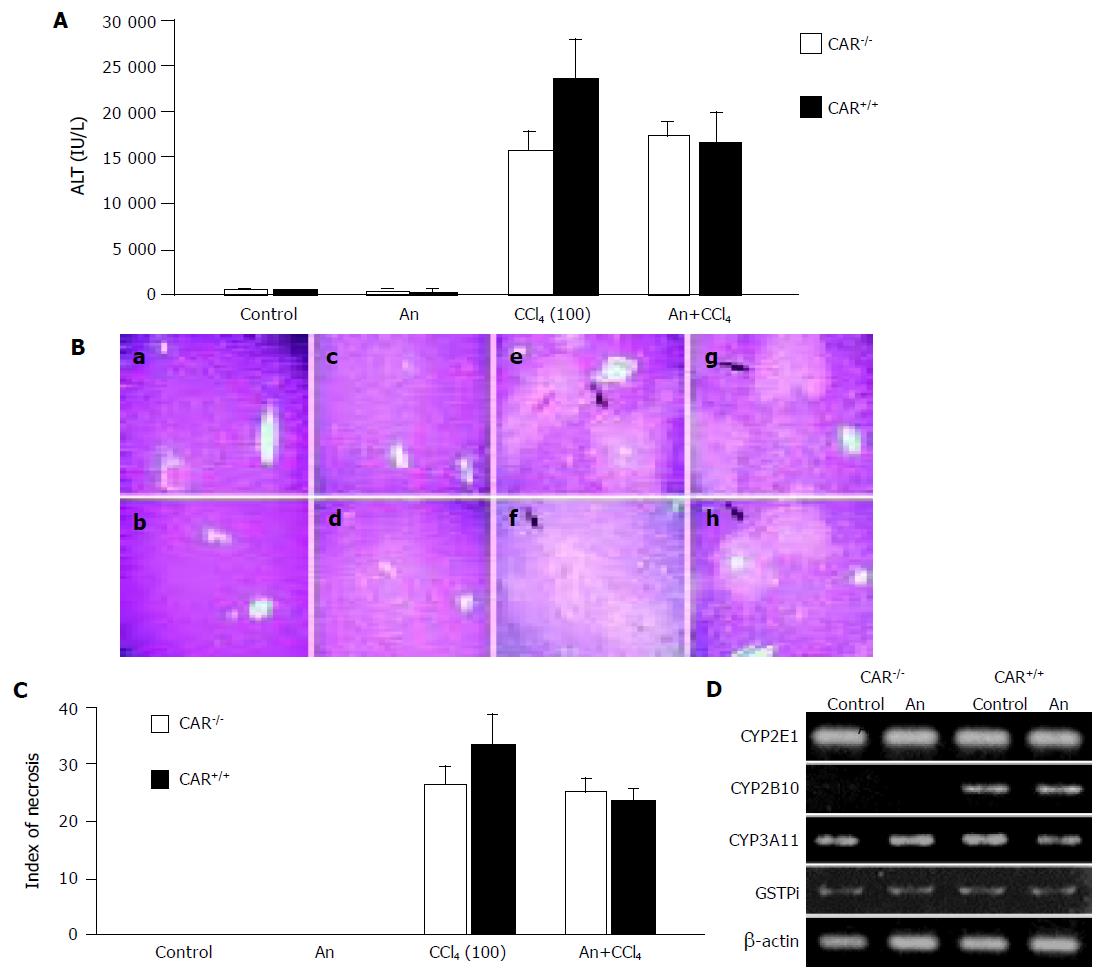Copyright
©The Author(s) 2005.
World J Gastroenterol. Oct 14, 2005; 11(38): 5966-5972
Published online Oct 14, 2005. doi: 10.3748/wjg.v11.i38.5966
Published online Oct 14, 2005. doi: 10.3748/wjg.v11.i38.5966
Figure 5 Androstanol prevented CCl4-induced hepatotoxicity.
(A) CAR+/+ or CAR–/– mice were given a 100-mg/kg dose of CCl4 by intraperitoneal injection, with or without pretreatment with androstanol (100 mg/kg). Serum ALT levels were measured 24 h later (n=6 per treatment group). Androstanol-pretreatment reduced the ALT level of CAR+/+ mice to the level of CAR–/– mice. An: androstanol. (B) Liver sections from the same animals 24 h after different treatments, as indicated, were stained with hematoxylin and eosin. (a) CAR–/– mice, control; (b) CAR+/+ mice, control; (c) CAR–/– mice, androstanol; (d) CAR+/+ mice, androstanol; (e) CAR–/– mice, CCl4; (f) CAR+/+ mice, CCl4; (g) CAR–/– mice, androstanol plus CCl4; and (h) CAR+/+ mice, androstanol plus CCl4. Androstanol pretreatment reduced the hepatic centrilobular necrosis in CAR+/+ mice. Arrows indicate areas of hepatic necrosis. (C) The indices of centrilobular necrosis in CAR+/+ mice and CAR–/– mice. Androstanol-pretreatment reduced hepatic centrilobular necrosis of CAR+/+ mice to the level of CAR–/– mice. Data in (A) and (C) are mean±SD. (D) Hepatic mRNA level of drug-metabolizing enzymes with androstanol treatment. Total liver RNA was prepared from CAR+/+ or CAR–/– animals treated with a 100-mg/kg dose of androstanol by intraperitoneal injection (n=6 per treatment group) and subjected to PCR analysis with the indicated primers in Materials and methods. β-Actin mRNA level was also measured as an internal control. The amplified DNA was separated on a 1.5% agarose gel and visualized with staining by ethidium bromide. The expected sizes of the amplified cDNA are described in Materials and methods.
- Citation: Yamazaki Y, Kakizaki S, Horiguchi N, Takagi H, Mori M, Negishi M. Role of nuclear receptor CAR in carbon tetrachloride-induced hepatotoxicity. World J Gastroenterol 2005; 11(38): 5966-5972
- URL: https://www.wjgnet.com/1007-9327/full/v11/i38/5966.htm
- DOI: https://dx.doi.org/10.3748/wjg.v11.i38.5966









